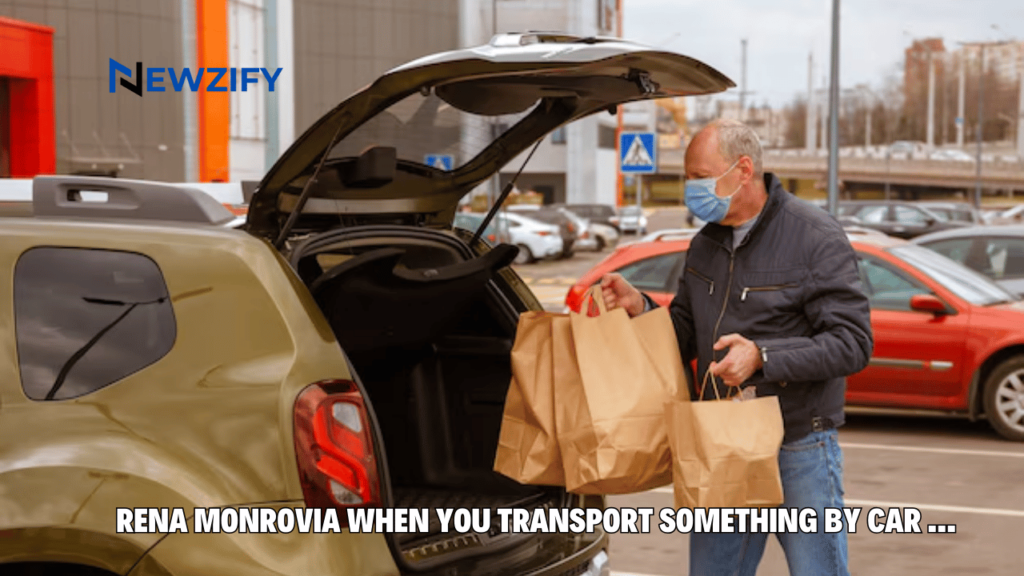Transporting goods by car is a common scenario for many of us, whether moving house, delivering products, or simply bringing home purchases. Understanding how to do this efficiently and safely is crucial, especially in bustling areas like Monrovia. This post will delve into the basics of car transportation, focusing on the concept of Rena Monrovia, a term that might refer to a specific method or model of transport in this region.
The term “rena monrovia when you transport something by car …” isn’t widely recognized, which suggests it could be a local service, a particular transportation strategy, or simply a new concept in the logistics industry. In this blog, we’ll explore what it could mean to transport something by car under the banner of Rena Monrovia, covering legal, safety, and efficiency considerations that could benefit drivers and businesses alike.
Table of Contents
Understanding Car Transportation Basics
When we think about transporting something by car, it typically involves short to medium distances where goods need to be moved quickly and economically. This method of transport is ideal for items that are too bulky or numerous to carry by hand but don’t justify the use of larger vehicles like trucks. In urban environments such as Monrovia, car transportation can also include delivering goods from businesses to customers, such as food delivery or small-scale retail products. Understanding the capacity of your vehicle, the nature of the goods being transported, and the best practices for securing them can make a significant difference in the efficiency and safety of the journey.
The basics of car transportation also involve legal considerations. Depending on the location, there may be specific regulations governing the transport of certain goods by car. This can include permits for transporting hazardous materials, restrictions on the weight and size of the cargo, or required documentation for commercial activities. Knowing these rules is essential to avoid legal issues and ensure a smooth transport process. Safety is another critical aspect, involving the proper stowage of items to prevent damage during transit and ensuring they do not pose a hazard by shifting or obstructing the driver’s view.
Key Strategies for Efficient Car Transportation
Planning your journey is one of the most effective strategies for efficient car transportation. This involves selecting the best route based on traffic conditions, road types, and distances. Using GPS navigation aids can help identify the quickest routes while avoiding traffic jams or roadworks that might delay delivery. Additionally, optimizing the arrangement of items within the vehicle is crucial. Effective packing not only helps in fitting more items into the space available but also in maintaining the balance and handling of the car, which can be affected by unevenly distributed weight.
Choosing the right vehicle for the type of goods you are transporting also plays a fundamental role in efficiency. For heavier or bulkier items, a car with a spacious trunk or a fold-down rear seat can provide the necessary space while maintaining the vehicle’s maneuverability. For delicate items, a car with a smooth ride and good suspension would be preferable to protect the cargo from jolts and vibrations. Regular maintenance of the vehicle, such as checking tire pressure, fluid levels, and brake conditions, is also vital to ensure that the transport goes smoothly and safely without unexpected breakdowns.
Rena Monrovia: A Case Study
In the context of rena monrovia when you transport something by car …, this could either refer to a particular model of a vehicle that is optimized for urban transport or perhaps a specialized service offering logistic solutions within Monrovia. If it is a vehicle model, the features that would make it ideal for city logistics might include fuel efficiency, ease of maneuvering in tight spaces, and adequate cargo space without compromising on passenger comfort. On the other hand, if Rena Monrovia refers to a service, it might be designed to streamline the process of booking, scheduling, and managing transport tasks, with a focus on local businesses and consumer needs.
Exploring Rena Monrovia as a case study allows us to consider the specific requirements and challenges of transporting goods in an urban setting. This could include dealing with traffic congestion, navigating narrow streets, or scheduling deliveries around peak urban activities. By understanding how Rena Monrovia addresses these challenges, whether as a vehicle or a service, other businesses and individuals can glean insights into improving their own transport strategies within similar environments.
Technological Aids for Car Transportation
The role of technology in car transportation cannot be overstated. GPS and real-time tracking technologies not only help in route planning but also allow both senders and recipients to monitor the progress of the delivery. This increases transparency and trust, particularly in commercial transactions. Applications and software that assist in cargo management can help drivers optimize the order of deliveries, reducing the time spent on the road and fuel consumption. Additionally, newer innovations like autonomous driving technology could revolutionize car transportation by reducing the need for manual driving, thereby potentially increasing safety and efficiency.
Other technological aids include systems that assist in loading and unloading cargo, such as portable lifts or automated guides that can help prevent injuries and speed up the process. For personal car transport, simple gadgets like cargo organizers or protective liners can enhance the transport experience by keeping goods secure and preventing damage to the vehicle’s interior. As technology continues to evolve, its integration into car transportation will likely become more advanced, offering even greater benefits to drivers and businesses alike.
Safety Protocols and Emergency Handling
Safety is paramount when transporting goods by car. This starts with the proper stowage of items to ensure they are secure and will not move around during transit. It is important to use suitable tying aids and padding to protect fragile items and to ensure that heavier items are not placed on top of lighter ones. Regular checks during stops can help catch any issues before they lead to accidents or damage. Additionally, understanding how to handle emergencies on the road is crucial. This includes knowing basic first aid, having the right tools to address minor mechanical issues, and being prepared to contact emergency services when needed.
Drivers should also be trained in defensive driving techniques to avoid accidents, especially when transporting valuable or hazardous materials. Keeping an emergency kit in the vehicle, including items like a first aid kit, flashlight, and basic tools, can also be a lifesaver in unexpected situations. Finally, insurance is a critical component of transporting goods, providing financial protection against accidents, theft, and other mishaps that might occur during transportation.
FAQs about Transporting Goods by Car
- What is the best way to secure items in a car during transport? Secure items using straps, bungee cords, or cargo nets to prevent movement and potential damage.
- Are there legal restrictions for transporting goods by car? Yes, legal restrictions can include permits for hazardous materials, weight limits, and required documentation for commercial transport.
- How can technology help in transporting goods by car? Technology aids like GPS for routing, apps for cargo management, and real-time tracking systems enhance efficiency and safety.
- What should be included in an emergency kit for car transportation? An emergency kit should include a first aid kit, tools, a flashlight, and emergency contact numbers.
- How can I choose the right vehicle for transporting goods? Consider the size, cargo capacity, and handling characteristics of the vehicle, especially for urban environments like Monrovia.
Conclusion
Efficient and safe transportation of goods by car is achievable with careful planning, adherence to legal requirements, and the use of appropriate technological aids. As we have explored, even hypothetical or less understood concepts like rena monrovia when you transport something by car … can offer valuable insights into better transport methods, particularly in challenging urban environments like Monrovia. By implementing the strategies discussed, individuals and businesses can improve their transportation processes, ensuring that goods arrive safely, on time, and in good condition. With ongoing advancements in technology and vehicle design, the future of car transportation looks promising, continuing to evolve towards greater efficiency and safety.
Read More: classroom 15x



